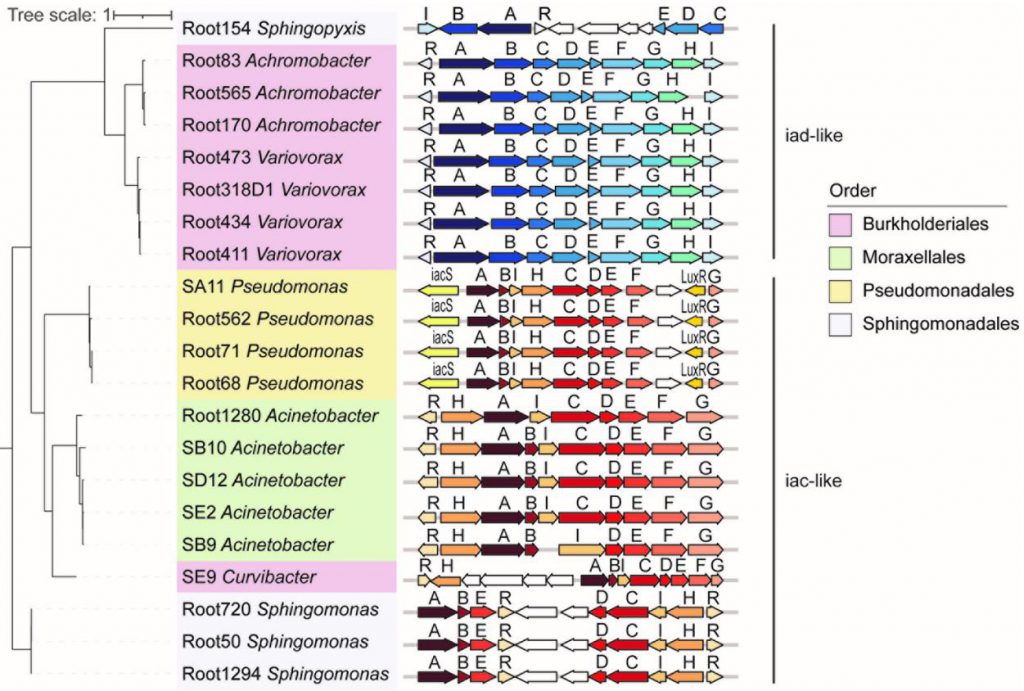Recently, Lei Dai's research groupat the Chinese Academy of Sciences published a research paper titled "Systematic characterization of plant-associated bacteria that can degrade indole-3-acetic acid” in PLOS Biology. The team combined genomic analysis and in vitro experiments to systematically study the ability of 183 bacteria isolated and cultured from the rhizosphere of Arabidopsis and rice to degrade indole-3-acetic acid (IAA), and explored the biological significance of these IAA-degrading bacteria through plant inoculation experiments. The results reveal the potential impact of rhizosphere microbial metabolism on plant growth and development, which is of great significance for understanding the interaction mechanism between symbiotic microorganisms and hosts.
Auxins are an important class of hormones in plants, widely involved in regulating plant growth, development and response to changes in the external environment. Auxin research began in the late 19th century and is one of the earliest discovered plant hormones. As the main natural auxin molecule, IAA is the most abundant in plants and plays a key role in many developmental processes of plants, including cell division, root development, cell wall expansion, vascular pattern formation and flowering. In addition to the plants themselves, some members of the microbial community that coexists with plants can also synthesize or degrade IAA, thereby affecting the interaction with the plant host. For example, a study reported that Variovorax is a core member of the plant microbial community, which regulates plant hormone levels by degrading IAA to balance the effect of the microbial community on root growth.
It is reported that 80% of plant rhizosphere symbiotic bacteria can synthesize IAA, a small molecule compound that helps microorganisms colonize the root system. However, how many microorganisms in the rhizosphere have the ability to degrade IAA? Their molecular mechanisms for degrading IAA and the roles they play in the rhizosphere need further study. Understanding this knowledge will provide us with a promising ecological strategy for developing more stress-resistant and productive crops.
Based on these research questions, the research team first used a combination of comparative genomics and in vitro degradation experiments to systematically evaluate the IAA metabolic capacity of 183 bacterial strains isolated from the roots of Arabidopsis thaliana and rice (Oryza sativa). Finally, a total of 21 bacterial strains from 7 genera were identified to have IAA degradation activity, including new bacterial genera that had not been reported before.
Studies have shown that in the genomes of these IAA-degrading strains, the metabolic gene clusters responsible for degrading IAA are iac-like operons or iad-like operons. Transcriptome analysis found that the expression of these gene clusters is induced by IAA. It is worth noting that these gene clusters are generally regulated by a regulator MarR (Multiple Antibiotic Resistance Regulator) with highly conserved structure among species.

Figure 1. Characteristics of IAA degradation-related gene clusters. (Wang, et al., 2024)
In addition, the research team found that some IAA-degrading strains can use IAA as a carbon source. The results of the plant inoculation experiment showed that some IAA-degrading strains can alleviate the plant taproot growth inhibition caused by excessively high IAA concentrations in the environment. It is inferred that IAA-degrading bacteria may make an important contribution to maintaining the steady state of plant rhizosphere auxin concentrations, suggesting that IAA-degrading bacteria play an important role in the growth and development of host plants in the rhizosphere microenvironment.
By integrating and analyzing the frequencies of biomarker genes in metagenome-assembled genomes (MAGs) and whole genome sequences (WGS) of microbial isolates collected from different ecological environments, the authors observed that IAA-degrading bacteria had a colonization preference trend from aquatic environments to terrestrial environments, from soil matrices to plants, and further from plant aerial parts to roots, indicating that there may be a close association between IAA-degrading bacteria and IAA producers (including plants and IAA-synthesizing microorganisms).
This study systematically analyzed the diversity of IAA-degrading bacteria in plant rhizosphere microorganisms and their potential ecological functions. By combining genomics and experimental methods, 21 bacteria with IAA degradation activity were identified and revealed, and their degradation mechanisms and their roles in regulating plant hormone levels were deeply analyzed. The research results not only deepen our understanding of the relationship between rhizosphere microorganisms and plant growth, but also provide a scientific basis for the development of ecological strategies that can improve crop stress resistance and productivity. Future studies can further explore the distribution of these IAA-degrading bacteria in different ecosystems and their interaction mechanisms with host plants, opening up new paths for agricultural and ecological applications.
| Cat# | Product Name | Inquiry |
| AUX-469 | (2,4-Dichlorophenoxy)acetic acid sodium salt monohydrate | Inquiry |
| AUX-470 | 1-Naphthaleneacetic acid | Inquiry |
| AUX-471 | 2,4,5-Trichlorophenoxyacetic acid | Inquiry |
| AUX-472 | 2-Naphthoxyacetic acid | Inquiry |
| AUX-473 | 3-Indoleacetic acid | Inquiry |
| AUX-474 | Indole-3-butyric acid | Inquiry |
| AUX-475 | Picloram | Inquiry |
| AUX-500 | 2,4-Dichlorophenoxyacetic acid | Inquiry |